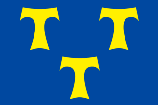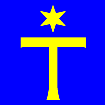1) See "cross counterchanged" above.
2) The term that may also be used when the centre of a cross of this general
type is obscured as illustrated below. See "cross gyronny" below.
A heraldic term sometimes used when a cross (either plain or decorated) does not extend to edges of a shield,
banner of arms or flag (see also couped 2) and Greek cross).

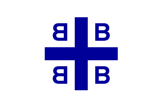

Example; Putative Flag of Constantine the Great c325 AD;
Flag of Treiten, Switzerland
Please note that, unless referring to a plain cross, this term is always
accompanied by a further description, for example a "cross tau couped" (as illustrated above), or
"cross crosslet couped" as shown in the following definition.
Cross Crosslet
The heraldic term for a cross which does not usually extend to the edges of a shield, flag canton or panel,
but whose arms have a short transverse bar inserted (see also cross 2)).

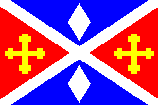
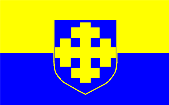
Example; Flag of Echt-Susteren, The Netherlands;
Flag of Slupca, Poland
Cross-Fitchy
The heraldic term for a cross which does not usually extend to the edges of a shield, flag, canton or panel,
and which may have plain or decorated ends, but whose vertical arm comes to a point at its base (see also
cross 2) and cross of Santiago).


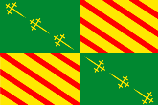
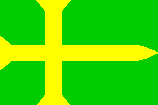
Examples; Flag of Bernissart, Belgium; Flag of Avinyó, Spain
Please note that, unless referring to a plain cross, this term is always accompanied
by a further description, for example a "cross crosslet fitchy".
Cross Fleury Fitchy
See
cross of Santiago.

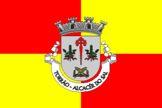
Arms and Flag of Torrão, Portugal
Cross Fleury (or Flory, Floretty or Fleuronny)
The heraldic term for a cross which does not usually extend to the edges of a shield, flag, canton or panel, but
whose ends are formed by fleur-de-lis – a fleur-de-lis or fleury cross, avis cross, or
cross of calatrava (see also avis cross, cross 2),
Dominican cross,
cross of Calatrava,
fleur-de-lis and fleury).
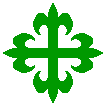
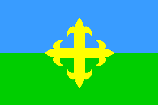
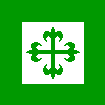 Suggested Flag of the Avis Order, Portugal;
Flag of Guriezo, Spain;
Flag of the Portuguese Legion c1928–1974
Suggested Flag of the Avis Order, Portugal;
Flag of Guriezo, Spain;
Flag of the Portuguese Legion c1928–1974
Cross Gringolée
See snakehead cross.

Cross Gyronny
The heraldic term for a cross that may or may not extend to the edges of a shield,
flag or panel, but is composed of two tinctures meeting at the centre point and
alternating either side of the vertical and horizontal meridians (thus giving it a
three-dimensional appearance) – a gyronny cross – see gyronny
and compare with "Cross Counterchanged" above (also Dominican cross,
faceted).
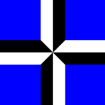
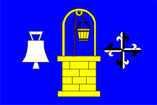 Flag of Safiental, Switzerland;
Flag of Studnice, Czechia
Flag of Safiental, Switzerland;
Flag of Studnice, Czechia
Notes:
a) Unless describing a plain cross throughout, this term should
always be accompanied by a further description, for example a "cross fleury gyronny couped".
b) A cross whose centre is obscured by a charge (as illustrated below)
could be described as either a cross gyronny or a cross-counterchanged, however, the term
"cross quartered" has now come into use – see cross quartered.

Flag of Santa Cruz de La Palma, Spain
Crosslet
1) The heraldic term used when two or more crosses are borne (couped) on the same coat –
but see "cross-cantonée" and "cross-crosslet" above (also
couped).
2) A term also (incorrectly) used to describe a single small cross.
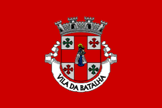

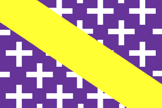
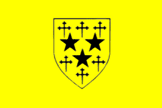
Flag and Arms of Batalha, Portugal; Flag of
Òdena, Spain; Flag of Somerville College Oxford, UK
Cross Moline
The heraldic term for a cross which does not usually extend to the edges of a shield, flag,
canton or panel, but whose ends are split into two curved pieces – an anchor or moline cross
(see also
cross 2) and
snakehead cross).

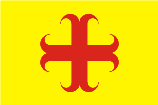
Example, Flag of Annœullin, France
Cross of Calvary (or Cross of Crucifixion)
The heraldic term for a Latin cross that does not usually (although it may) extend to the
edges of a shield, flag, panel or flag, but which is mounted on three steps steps – a cross of
crucifixion, a calvary cross or calvary
(see also Latin cross).
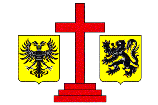
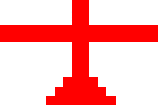 Flag of Geraardsbergen, Belgium; Flag of
Fulleda, Spain
Flag of Geraardsbergen, Belgium; Flag of
Fulleda, Spain
Cross Pattée (or Patée, Patty or Paty)
The heraldic term for a cross that may or may not extend to the outer edges of a shield, flag, canton
or panel, whose arms are generally (but not exclusively) flat-ended but which is wider at its outer ends than it is in the centre.
The arms can be straight-sided or curved throughout their length, or they can be straight-sided and parallel
until being flared at their outer end – a cross formée, formé or formy, a pattée, patée, patty or Paty cross, a
formée, formé or formy cross, or an iron, Hanseatic, Hansa, cavalier or cavalier's
cross – but see Maltese cross, rounded cross (also
cross 2) and
Cross of the Order of the Knights of Christ).

![[Wallis & Futuna]](../images/v/vxt-d592.gif)
![[Guernsey civil ensign]](../images/v/vxt-d592a.gif)
![[Cr. Jensen houseflag]](../images/v/vxt-d592b.gif)
Example; Flag of Wallis and Futuna;
Civil Ensign of Guernsey;
House flag of Chr. Jensen, Denmark
Cross Pomel (Pomée, Pommetty or Pommelly)
Cross Potent (or Potence)
The heraldic term for a cross which does not usually extend to the edges of a shield, flag,
canton or panel, but whose arms terminate in a transverse bar – a cross potence, or potent, or
a crutch or Teutonic Cross (see also
cross 2) and cross-cantonée
and potent 2)).

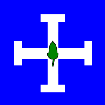
Example; Flag of Goumoëns-la-Ville, Switzerland
Cross-Potent Cantonée
See "Cross Potent" and "Cross-Cantonée" above.

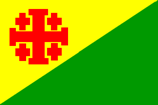

Example; Flag
and Arms of Niawier, The Netherlands
Cross Tau
Cross-Voided
The heraldic term for a cross that may or may not reach the edges of a shield, banner of arms or flag and
may be either closed or open-ended, but from which the centre is removed so that the field may be seen through it
(see also cross of athletics and voided).

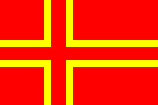
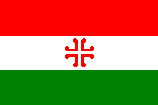 Example; Flag of Mouvement Normand, France;
Flag of De Haan, Belgium
Example; Flag of Mouvement Normand, France;
Flag of De Haan, Belgium
Notes:
a) Unless referring to a plain cross, this term is always accompanied
by a further description, for example "a cross pattée voided".
b) This term is sometimes (incorrectly used to describe a
Cross of the Order of the Knights of Christ as illustrated below – see
Cross of the Order of the Knights of Christ.
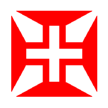
A banner of the Order of the Knights of Christ
Latin Cross
The heraldic term for a cross that does not usually extend to the edges of a shield, flag,
panel or flag, but whose horizontal arm is shorter than its vertical and which is set above the
centre line – a long cross (see also
Greek cross and cross 2)).
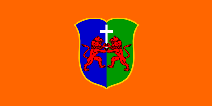

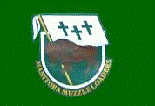

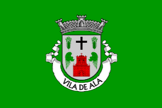 Flag and Arms of Budinšcina, Croatia;
Flag of the Muzzle Loaders of Manitoba, Canada;
Arms and Flag of Vila de Ala, Portugal
Flag and Arms of Budinšcina, Croatia;
Flag of the Muzzle Loaders of Manitoba, Canada;
Arms and Flag of Vila de Ala, Portugal
Notes:
1) Unless referring to a plain cross, this term should always
be accompanied by a further description, for example a "Latin cross treflée" as
illustrated below.
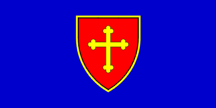
Flag of Negoslavci, Croatia
2) In vexillological terms a Latin cross throughout becomes
an off-centred cross – see off-centred cross 2) (also throughout).
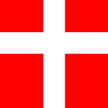
Flag of Thunstetten, Switzerland
Introduction | Table of Contents
| Index of Terms | Previous Page | Next Page


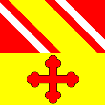



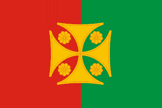
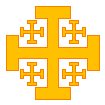
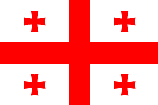
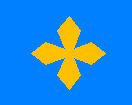

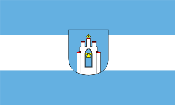
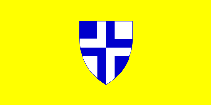
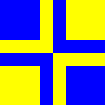
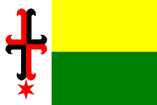
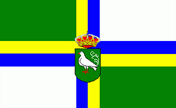
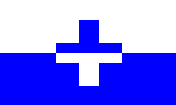





























![[Wallis & Futuna]](../images/v/vxt-d592.gif)
![[Guernsey civil ensign]](../images/v/vxt-d592a.gif)
![[Cr. Jensen houseflag]](../images/v/vxt-d592b.gif)

![[Lagoa Portugal]](../images/v/vxt-d2597.gif)
![[Lagoa Portugal]](../images/v/vxt-d2599.gif)
![[Lagoa Portugal]](../images/v/vxt-d2598.gif)





